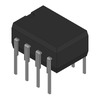Manufacturer Part Number
LM311M/NOPB
Manufacturer
Texas Instruments
Introduction
The LM311M/NOPB is a general-purpose linear comparator that can be used in a wide range of applications, including analog-to-digital conversion, limit detection, and zero-crossing detection. It is a single-element comparator that offers a variety of output types, including DTL, MOS, Open-Collector, Open-Emitter, RTL, and TTL.
Product Features and Performance
Single-element comparator
Operates from a single supply voltage of 5V to 36V or dual supply voltages of ±2.5V to ±18V
Low input offset voltage of 7.5mV (max) at ±15V
Low input bias current of 0.25µA (max) at ±15V
Typical quiescent current of 7.5mA
Product Advantages
Versatile output options to suit a variety of circuit requirements
Wide supply voltage range for use in diverse applications
Excellent input offset voltage and bias current characteristics for precise comparisons
Robust design for reliable operation
Key Reasons to Choose This Product
Proven reliability and performance in a wide range of applications
Cost-effective solution for general-purpose comparator needs
Easy integration into various circuit designs due to the flexible output options
Backed by the renowned quality and technical support of Texas Instruments
Quality and Safety Features
Manufactured using high-quality standards to ensure reliability and consistency
Designed to meet industry safety and regulatory requirements
Compatibility
Compatible with a variety of digital and analog logic families, including DTL, MOS, Open-Collector, Open-Emitter, RTL, and TTL
Application Areas
Analog-to-digital conversion
Limit detection
Zero-crossing detection
Voltage regulation
Waveform generation
Timing and control circuits
Product Lifecycle
The LM311M/NOPB is an active product in the Texas Instruments portfolio. There are no immediate plans for discontinuation. However, customers are advised to check with their sales representative or contact our website's sales team for the latest product information and availability of any potential alternative or equivalent models.

 LM311MXTexas InstrumentsIC COMPARATOR 1 GEN PUR 8SOIC
LM311MXTexas InstrumentsIC COMPARATOR 1 GEN PUR 8SOIC LM311DGonsemiIC COMPARATOR 1 GEN PUR 8SOIC
LM311DGonsemiIC COMPARATOR 1 GEN PUR 8SOIC LM3150MHTexas Instruments
LM3150MHTexas Instruments LM311MXonsemiIC COMPARATOR 1 GEN PUR 8SOIC
LM311MXonsemiIC COMPARATOR 1 GEN PUR 8SOIC LM311PTexas InstrumentsIC COMPARATOR 1 GEN PUR 8DIP
LM311PTexas InstrumentsIC COMPARATOR 1 GEN PUR 8DIP LM311JGNULLIGBT Module
LM311JGNULLIGBT Module LM311J-8Texas InstrumentsIC COMPARATOR 1 DIFF 8CDIP
LM311J-8Texas InstrumentsIC COMPARATOR 1 DIFF 8CDIP LM311DTSTMicroelectronicsIC COMPARATOR 1 GEN PUR 8SOIC
LM311DTSTMicroelectronicsIC COMPARATOR 1 GEN PUR 8SOIC LM311NSTMicroelectronicsIC COMPARATOR 1 GEN PUR 8DIP
LM311NSTMicroelectronicsIC COMPARATOR 1 GEN PUR 8DIP